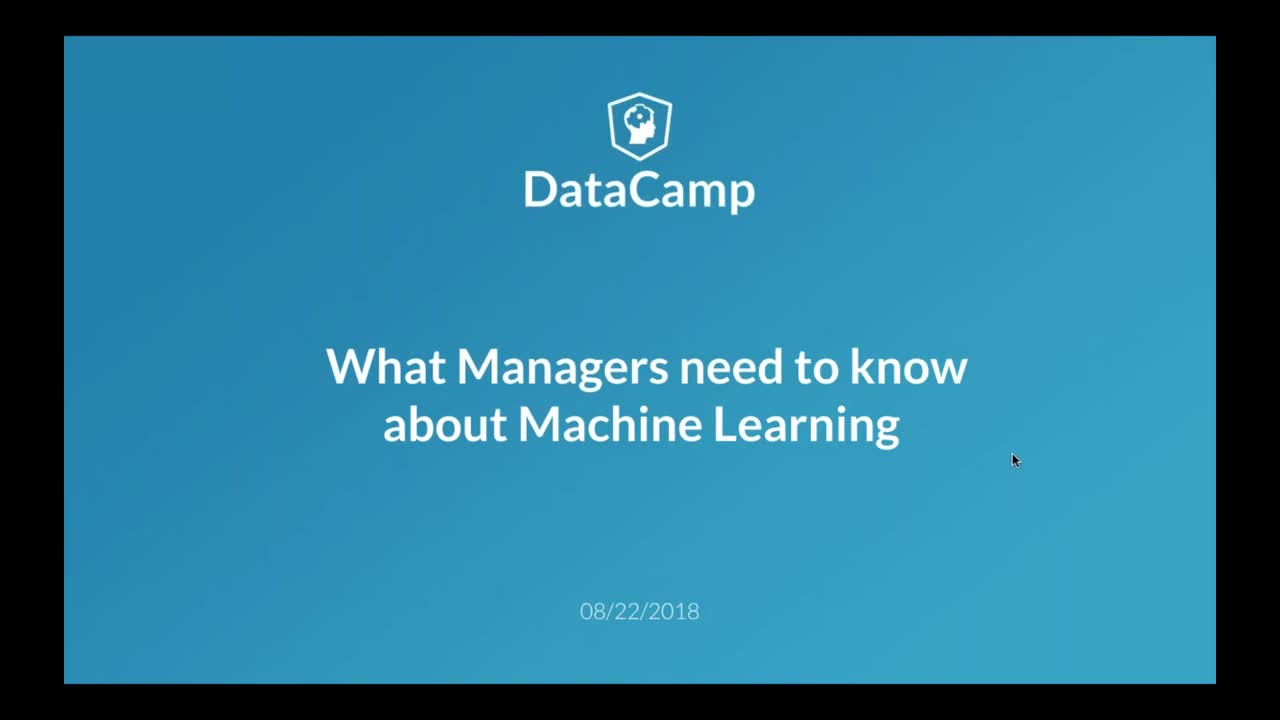Speakers
Training 2 or more people?
Get your team access to the full DataCamp library, with centralized reporting, assignments, projects and moreWhat Managers Need To Know About Machine Learning
November 2021
Summary
In an era heavily influenced by data, grasping machine learning is essential for business leaders across sectors. Machine learning connects the dots between data science and business decision making by transforming complex terms into actionable insights. The discussion explores the various applications of machine learning, such as predicting customer churn, medical image diagnosis, and text classification. The conversation then moves to investigate unsupervised learning for pattern recognition and the importance of dimensionality reduction for efficient data management. Key techniques like supervised learning, classification, regression, and clustering are highlighted, equipping managers with the necessary tools to engage in productive dialogue with data scientists. A considerable focus is placed on understanding the limitations and potential of machine learning models, ensuring that they serve as effective decision-making tools rather than purely technical exercises. Hugo Bown-Anderson emphasizes the need to overcome computational and language barriers to fully utilize the capabilities of machine learning. He articulates the need for managers to not only understand the technical aspects but also to translate business challenges into data science problems and back into business solutions.
Key Takeaways:
- Machine learning is vital for solving prediction problems in businesses.
- Managers should concentrate on translating business problems into data science terminology.
- Understanding the types of machine learning—supervised, unsupervised, and reinforcement—is essential.
- Data pre-processing and feature engineering are important steps in the machine learning process.
- There's a trade-off between model accuracy and interpretability.
Deep Dives
Understanding Machine Learning for Business Leaders
Machi ...
Read More
Applications of Machine Learning in Business
Machine learning addresses a wide range of prediction problems in business, from forecasting customer churn to diagnosing medical images and classifying text. These applications are categorized into supervised and unsupervised learning. Supervised learning, suitable for predictive analytics, involves labeled data to train models that predict outcomes like whether a customer will churn. Unsupervised learning, on the other hand, focuses on pattern recognition and data exploration, aiding in tasks such as user segmentation and clustering. The webinar highlights the practical applications of ML, encouraging business leaders to understand these techniques to enhance business solutions.
Supervised Learning Techniques
Supervised learning is important for predictive analytics, employing algorithms to learn from labeled datasets. The process involves two main types: classification and regression. Classification deals with categorical outcomes, such as predicting if a tumor is benign or malignant, while regression focuses on continuous outcomes like estimating house prices. Hugo explains the importance of model evaluation, emphasizing metrics beyond accuracy to ensure strong performance. Techniques like train-test split and K-fold cross-validation are essential for validating model reliability. Business leaders are encouraged to engage with data scientists, asking informed questions about model performance and hyperparameter selection.
Unsupervised Learning and Clustering
Unsupervised learning, a key aspect of ML, is used for exploratory data analysis and pattern recognition without predefined labels. Clustering, a common unsupervised technique, segments data into meaningful groups. Hugo discusses various clustering methods, such as K-means and hierarchical clustering, illustrating their applications in business, from user segmentation to stock movement analysis. Business leaders are urged to understand the limitations and potential of these techniques, promoting collaboration with data scientists to utilize clustering for strategic insights. Clustering not only reveals trends but also informs feature engineering, enhancing predictive models.
Dimensionality Reduction and Efficiency
With the surge of data, efficient handling is essential. Dimensionality reduction techniques like Principal Component Analysis (PCA) reduce the number of variables while preserving essential information. This process enhances computational efficiency and storage while minimizing noise in datasets. Hugo illustrates the concept using tumor measurement data, demonstrating how PCA identifies principal components that capture the most variance. Business leaders can discuss with data scientists about balancing information loss with gains in efficiency, ensuring that the reduced dataset is still informative for decision-making. Understanding intrinsic dimensions helps optimize data management, simplifying the data science process for better business outcomes.
Related
The Definitive Guide to Machine Learning for Business Leaders
Craft a 21st-century data strategy to optimize business outcomes.white paper
The Difference Between AI and Machine Learning
Find out where AI, ML, and data science intersect and where they diverge.webinar
Artificial Intelligence for Business Leaders
We'll answer the questions about AI that you've been too afraid to ask.webinar
Machine Learning for Investment Finance
Discover the common use cases for machine learning in investment finance.webinar
A Practical Guide to MLOps
Learn how to begin your MLOps journey in your organizationwebinar
